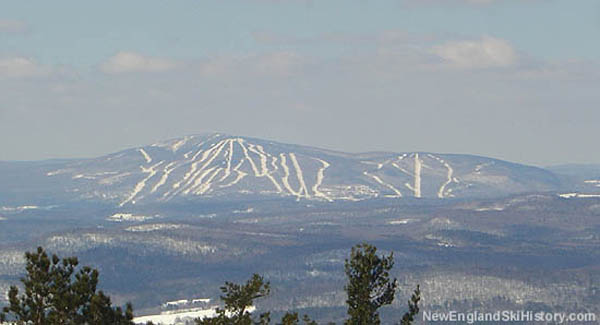
|
|
Located on 3,343 foot Ludlow Mountain, Okemo Mountain Resort is one of the most popular ski areas in New England. Okemo is said to be a Native American word that means "All Come Home."
Early Years and Okemo Outing Club
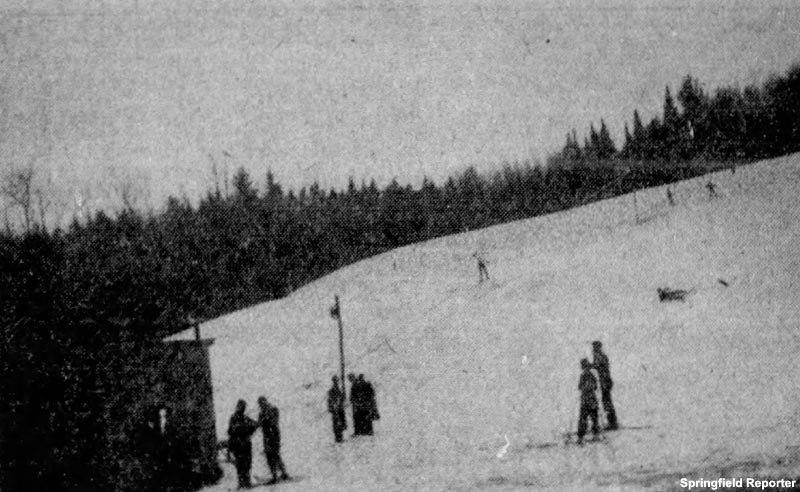
The Okemo Outing Club rope tow circa 1938 |
Okemo State Forest dates back to June 1935, when the State of Vermont acquired 4,000 acres of land from Parker Young and Company's Woodstock Lumber Company. The $9,250 ($2.31 per acre) purchase quickly drew sharp criticism from state legislators, as the funds had been earmarked for State Emergency Board public works projects. Nevertheless, plans for a major park were formulated by State Forester Perry Merrill using Civilian Conservation Corps ("CCC") labor. CCC crews were soon on-site, constructing an auto road, picnic areas, and various trails.
A big force in the development of the new facilities and activities was Merrill F. Proctor. Born in Rockingham, Proctor's earlier career was spent working in the hardware business in New Hampshire before relocating to Ludlow with his wife Verna in 1921. Proctor purchased Henry Brown's hardware store in town and became increasingly involved with local civic organizations, eventually serving a few years in the state legislature in the late 1920s and early 1930s. With the CCC developing a 1.75 mile ski trail on the Healdville side of Ludlow Mountain and a 700 vertical foot bobsled run in Proctor-Piper State Forest, Proctor helped to organize the Okemo Outing Club to coordinate winter carnivals. More than a thousand spectators were reported over the two-day Black Valley Carnival in February 1936. One point of criticism was that the ski events were so far away from Ludlow.
In January 1937, the Okemo Outing Club proposed installing a rope tow on the Ludlow side of the mountain. Meanwhile, four ski trails were proposed. The club continued to discuss the rope tow in early 1938, but decided not to proceed due to the anticipated cost. This changed later in the winter, when the club obtained permission to construct a tow on the Walter Slack farm north of town near Lake Rescue. The lift debuted on March 7, attracting hundreds. Okemo Outing Club, Inc. was formed around this time to provide facilities and promote winter and summer sports.
The Okemo Outing Club tow was realigned and lengthened for the 1938-39 season, becoming the site of the winter carnival snow events. A ski school was established that winter, operated by Ronald Colby.
The tow was once again lengthened for the 1940-41 season (to 900 feet), with the motor being relocated to the top to operate faster. The tow continued to operate through the winter of 1941-42, continuing to draw local and out-of-state skiers. However, with World War II in full swing, the Okemo Outing Club decided to cease operating the tow prior to the winter of 1942-43. With the CCC now disbanded, the crew's buildings began to collapse. It also seems that the ski trail on Ludlow Mountain ceased to be maintained. Meanwhile, the Okemo Outing Club sold the rope tow equipment, which was set up behind the Ludlow school prior to the 1944-45 season.
Okemo Mountain, Inc.
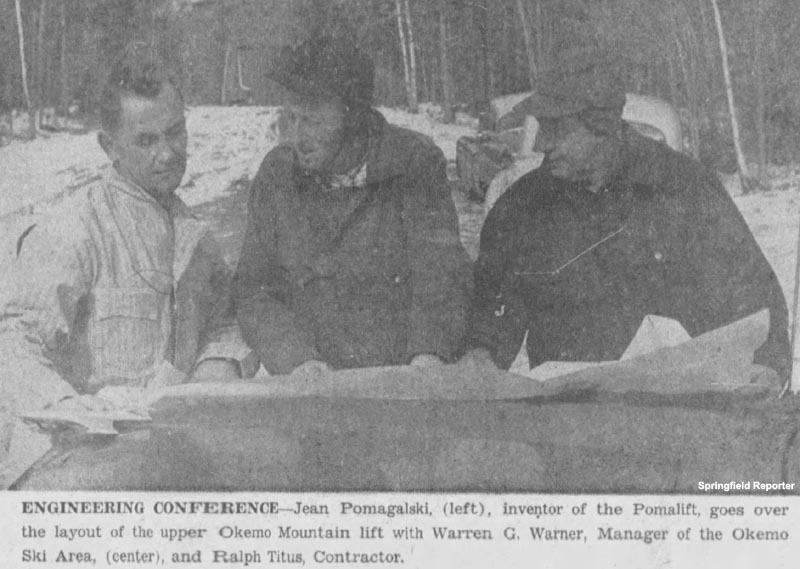
Jean Pomagalski, Warren Warner, and Ralph Titus during construction (1955) |
Following World War II, Ludlow did not immediate regain its status as a skiing destination. However, in 1953 a group of Ludlow citizens (including Merrill Proctor) began discussions with Perry Merrill about developing a chairlift or surface lift served ski area on Ludlow Mountain.
On January 7, 1955, Okemo Mountain, Inc. was incorporated by a group of local businessmen. 374 acres of lower mountain land was purchased and plans were made to install tiered double chairlifts to the top of the mountain and possibly tap into the railroad at the base to bring skiers in from Rutland. A commitment was obtained from Perry Merrill that the state would lease 4,500 acres for the project. Donald Ayers, operator of a local gas station, was elected as the first president of the corporation, with Merrill Proctor, Ernest Moore (former Vermont Speaker of the House), and Allen Fletcher Jr. (son of the former Governor) serving as founding directors. Ayers' wife Margaret served as clerk and office manager.
The proposed initial stock offering was for 5,000 shares at $10 per share, only available to Vermont residents (in part to avoid Securities & Exchange Commission jurisdiction). Plans evolved as stock was made available, with a $125,000 estimated price tag (with the stock offering expanding to $200,000). Retired postal employee Philip Delano and banker Floyd Chaffee spent a considerable amount of time selling stock, with the added bonus that a purchase of 100 shares included a lifetime ski pass. The first stockholder was a 9 year old Ludlow resident named Susan Menander. Construction costs and timelines were reduced by using the already-existing auto road as a trail and by choosing to install Pomalifts instead of chairlifts. The Pomalifts were also chosen because of their safety features, as the circular disc minimized the chance of a person getting caught on the lift (as compared to a rope tow or T-Bar). Trails and lifts were laid out by Charlie Lord (Stowe trail designer), Joe Jones, Steven Rostas, and Andrew Titcomb (local architect and Okemo Vice President). Construction began on July 25, 1955 with a projected December opening, though rain and muddy conditions hampered progress.
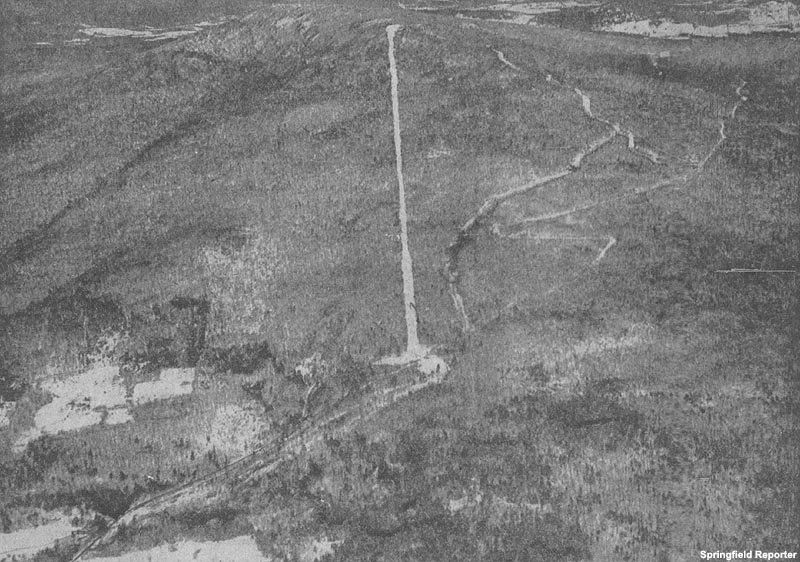
Okemo in 1955 |
In August, Warren Warner was named general manager. Previously employed as ski patrol director and Spruce Peak construction foreman at Stowe, Warner had two decades of experience as a forester with the United States Forest Service and Vermont State Forest Service.
By November, the corporation had $110,000 in pledged or sold stock. The 40-man construction crew was slowed at the beginning of the month due to an early snowstorm, putting the Christmas Eve opening in jeopardy. Though final lift wiring was completed in early January, there was inadequate snowpack to operate. Jean Pomagalski completed the final inspection of the new lifts in mid-January.
Okemo Opens
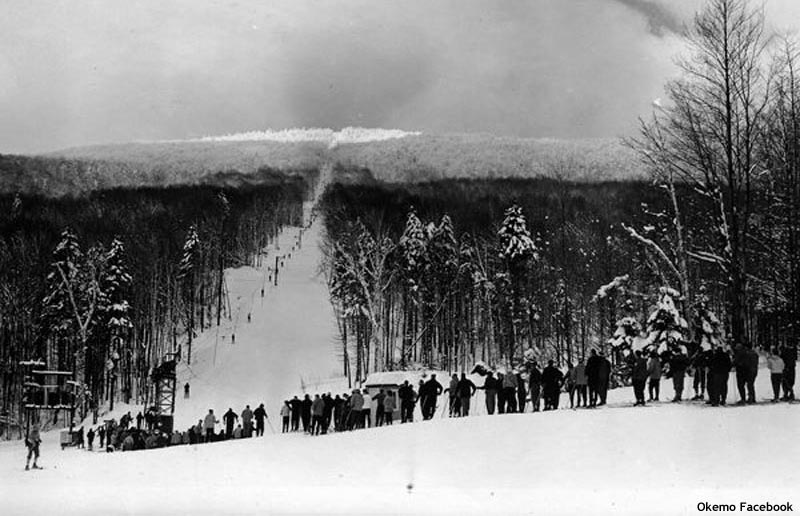
The Red Poma circa the 1950s |
An 11 inch snowstorm hit Okemo at the end of January, allowing for the area to finally debut on January 31, 1956. Three trails were served by the longest Pomalift in the country: the novice Squaw, the intermediate-expert Tomahawk, and Mountain Road. The lower Pomalift served the Papoose slope. Atop the paved access road, the state-constructed parking area could hold 800 cars. The state-operated Long House lodge was located at the base of the ski area, while the Wigwam warming hut, designed by Titcomb, was constructed at the top of the upper Pomalift.
An estimated 1,000 people visited Okemo during its debut weekend. The Springfield Reporter proclaimed, "Okemo Ski area was a dream yesterday. Today it is a reality. Tomorrow it will be a strong part of this section's recreation economy."
The inaugural ski school was directed by Karl Bauer, a German instructor who had previously taught at Mt. Snow. Staff included Bill Jenkins, Sandy Gregg, Kermit Upton, Dick Ireland, and Clif Taylor. Allen "Babe" Smith, formerly of Stowe, directed the ski patrol.
As the short debut season progressed, manager Warren Warner began discussing expansion plans, including three new trails planned for 1956-57. Okemo entered April with nearly four to five feet of base. The season likely ended on April 21, reportedly resulting in a slight operating profit.
In June 1956, general manager Warren Warner announced his resignation from Okemo and his family's return to Morrisville so that he could work on the new Smugglers Notch development. Days later, corporation president Donald Ayers announced his resignation.
Post-Debut Changes
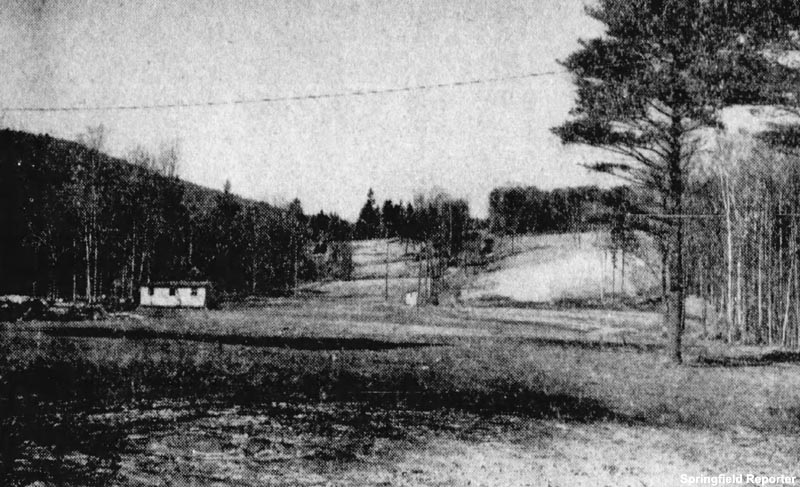
The base area in the fall of 1956 |
Andrew Titcomb took over as president of the corporation, hiring Vermont Academy and Dartmouth College graduate Donald Cutter as manager in September. A World War II Pacific theater veteran of the 10th Mountain Division, Cutter had been most recently involved in the construction of Dartmouth Skiway. Jerome Hickson was hired as ski school director.
Changes for the 1956-57 season included an improved parking area, the addition of the expert Chief trail, more open slope on either side of the lower lift, and a cutoff of Mountain Road. An additional $50,000 in stock was authorized. Meanwhile, the Board of Directors warned shareholders of an attempted hostile takeover of the company by a firm from Lunenburg Massachusetts, labelling it a "back-door approach to a business matter."
Following an early season snowstorm, Okemo started its sophomore season on December 9, though subpar conditions persisted through Christmas. Nevertheless, Okemo had its largest weekend yet following Christmas, as it filled its parking lot to capacity.
Despite persistently marginal conditions with bare spots often being disclosed in reports, Okemo remained in operation through the subpar winter. In February, a Vermont Junior Ski Council race was held on Tomahawk and Mountain Road. One young competitor was future Olympian Suzy Chaffee. The snow situation continued to deteriorate, as Okemo shut down at the end of February and remained closed until the second week in March, when a sizable storm briefly restored skiing. Skiers reportedly had to be transported to the upper mountain lift for the conclusion of the season on St. Patrick's Day weekend.
Improvements for the 1957-58 season included an improved access road funded by the state and a new warming hut. The season likely got underway with a few inches of snow on Mountain Road in early December. Rain dampened the season, as the Rutland Herald noted Okemo had no snow left by Christmas. Skiing resumed on New Year's Day after a few inches of snow fell. Snow continued to fall that month, leaving Okemo with nearly a two to four foot base by the end of the month.
In March 1958, Ludlow voters rejected an initiative to exempt Okemo from property taxes for five years. One voter alleged that the town was prioritizing plowing of the ski area access road over residential areas, while the corporation claimed it was handling most of the road maintenance. The tax exemption was rejected by a vote of 177 to 120.
By the end of March, base depths had grown to three to six feet. The 1957-58 ski season likely extended into the third weekend of April.
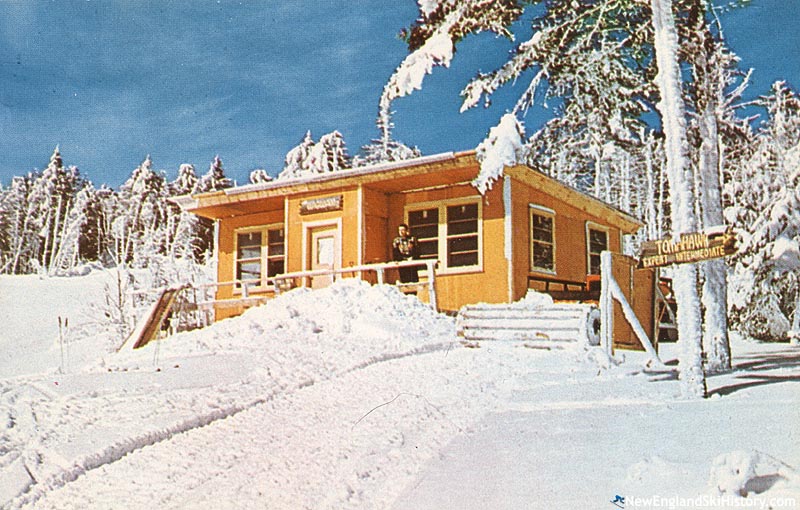
The Wigwam warming hut |
Noting that the lower mountain had the longest lift lines, Okemo Mountain, Inc. decided to invest in another novice lift. Clearing of five acres of additional novice terrain began during the 1958-59 season, with lift installation commencing in September. In addition, the corporation started discussing plans for year round operations, such as camping. Meanwhile, the access road was improved using state funds.
General manager Donald Cutter made headlines in late October, when he was declared "probably the first person in the area to do any skiing this year" following a five-inch snow storm on October 26.
Okemo was reportedly the first area to open in Vermont for the 1958-59 season, operating with limited terrain starting in late November. The area reported more than one to two feet of base by the weekend after Christmas. Momentum slowed in January 1959, as a rain storm resulted in deadly flooding in the lowlands and melting and subsequent icing on the ski slopes. Nevertheless, the increasingly popular ski area was still setting attendance records. One month later, Okemo set a single-day record on the Sunday before Washington's Birthday, recording 2,000 skiers.
The season melted out before the second weekend in April after 131 days of operation. Notching a 30% increase in revenue, Okemo Mountain, Inc. issued a 2 cents per share dividend to its stockholders. Corporation president Andrew Titcomb declared, "We do not pretend to be the greatest in the country or another Mt. Snow, but we do have a good, sound ski area."
Improvements for the 1959-60 season included widening Chief and Tomahawk, cutting glades, expanding restaurant seating, and acquiring an additional snow cat. The season started on limited natural snow during the weekend before Christmas, drawing 200 skiers on the second day of operation. Christmas weekend was a struggle due to "skimpy snow cover" and a power failure shutting down the upper mountain lift. A snow storm boosted business just before New Year's, starting the holiday period with 2,000 skiers. Unfortunately, the weekend was cut short by significant rain and high winds. Washington's Birthday was ushered in with a snow storm, resulting in strong business. The season likely came to a close in mid-April with business up 45%.
Pomas, Pomas, and More Pomas!
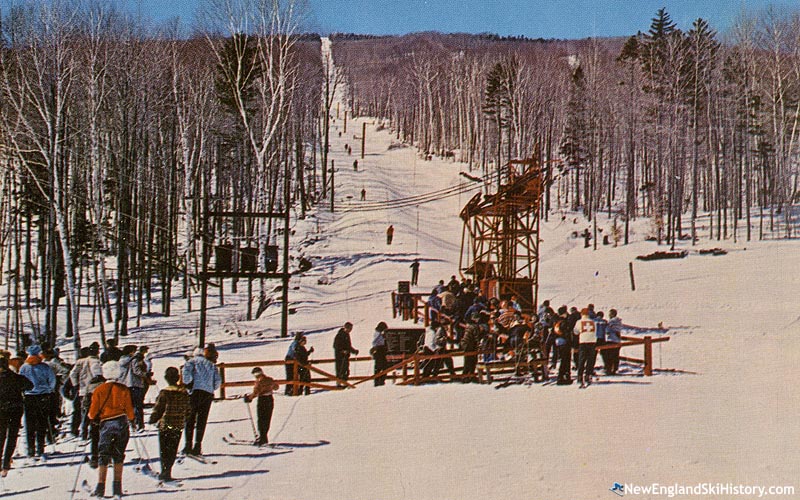
The Red Poma |
In May 1960, Okemo Mountain, Inc. announced a major expansion consisting of 35 acres of new terrain and a new 3,200 foot Pomalift to take pressure off the main mountain complex. A contract was signed that spring for the new lift and trail clearing commenced on May 2. The new trails in the complex were the expert Wardance, intermediate Arrow, and novice Bow, with an eye to expand upward to enhance summit offerings. A base lodge addition also took place, increasing restroom and repair shop facilities. In addition, another novice Pomalift was installed in the base area. The overall price tag of 1960's projects was nearly $100,000.
As the 1960-61 season arrived, season pass sales had reportedly doubled. The season likely started in mid-December on minimal snow before a pre-Christmas storm improved conditions. February had topsy-turvy weather, with spring conditions arriving for the second half of the month, followed by a multi-day closure. Multi-day closures due to lack of snow continued into early March before back-to-back snowstorms saved the season. The area once again closed at the start of April, only to reopen after another storm for a few days in the middle of the month. A trade publication later summarized the season by stating, "When Vermont snows dwindled last season in the midst of what is usually the whitest period of the winter, many area operators helplessly watched their cash positions melt with the snow. At Okemo Mountain, near Ludlow, Don Cutter merely pulled in his belt a notch, continued normal operation and wound up the season with a fair profit on the annual books in spite of it all" adding, "Cutter's pay-as-you-go program has kept Okemo clear of all major debt save for long-term financing of its five Pomalifts."
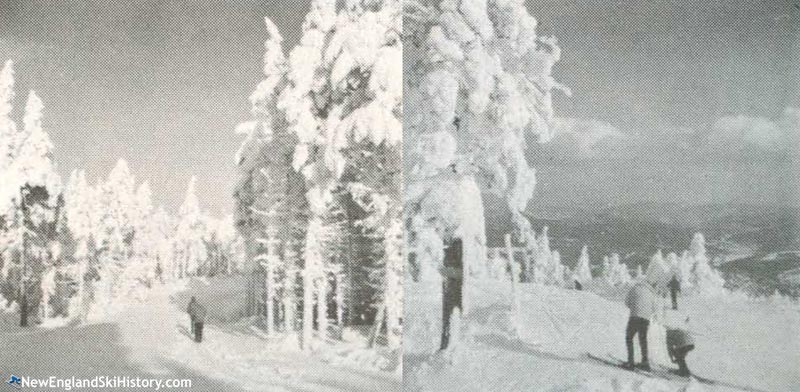
Okemo circa the early 1960s |
Following the season, eyes turned to Montpelier as lawmakers discussed the Okemo access road. The railroad underpass on the road was reportedly too small to allow for some buses to get to the ski area, so the state was loooking for the least expensive way to provide better clearance. The project took multiple years to come to fruition.
In June, Okemo Mountain, Inc. announced that it was selling 27 home sites. According to the company, the proximity of the lots to the base lodge was unusual for New England, since it would be possible to ski directly to the lifts. Plans were also discussed to develop slopeside lodging and a year-round dining facility. Roads and utilites for the development were constructed by the company. Meanwhile, the lower #2 lift (Blue Poma) was extended 500 feet uphill to provide better access to the upper #2 lift (Black Poma), Squaw was rebuilt, and a trail was cut through the Glades area.
The 1961-62 season started about a week before Christmas, with excellent conditions taking hold by the holiday with 6 to 12 inches of base. Business was booming, as Okemo recorded a record 4,700 skiers over the three-day New Year's weekend. General manager Donald Cutter attributed the increased business to ideal weather and conditions, as well as more visitors from Connecticut due to improved highways.
Base depths had grown to 2 to 5 feet by March, extending the season into early April. Revenue reportedly increased by 25%, resulting in shareholders receiving a 4% dividend.
Donald Cutter resigned as general manager in May 1962. Corporate president Andrew Titcomb noted that Cutter's leadership "brought the area over difficult times and through the years has contributed to a steady and commendable growth of the business of the corporation." Around this time, Cutter acquired the Art Bennett Sporting Goods Store in Hanover, New Hampshire. In February 1963, Cutter became manager of Dartmouth Skiway.
1962 off-season projects included doubling the size of the base lodge, a new nursery, and expanding the Papoose ski trail. Jay Peak assistant manager Daniel Leary was announced as Okemo's new general manager in September.
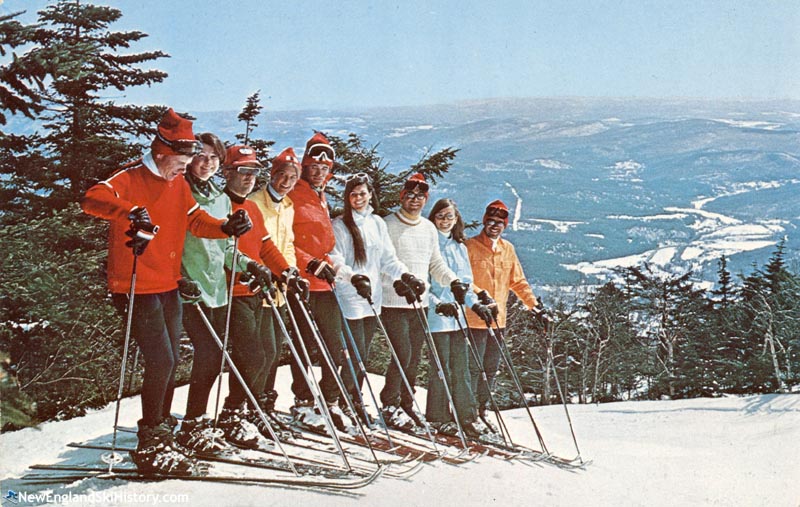
A ski school lesson at Okemo circa the 1960s or 1970s |
The 1962-63 season likely started just before Christmas on 2 to 6 inches of base. Natural snow accumulated over the winter, with a 3 to 6 foot base drawing record attendance for Washington's Birthday weekend.
Two months after resigning from the board of directors due to ill health, Okemo pioneer Merrill Proctor passed away on March 7, 1963 at the age of 79.
A few days later, Okemo hosted Governor's Day amidst a snowstorm, with Governor Philip Hoff presiding over a children's race, luncheon, and sugar-on-snow party.
Following the successful 1962-63 season, Okemo announced it was installing a new Pomalift on the upper mountain, serving the new Upper War Dance and Upper Arrow trails. The Okemo Mountain Inc. annual meeting that summer was contentious, as a group of dissatisfied shareholders attempted to unseat the board of directors. The group was unsuccessful, but David Rock was elected president, taking the place of Andrew Titcomb. Plans were discussed for future expansion to include two chairlifts.
As the season approached, details of the changes emerged. Upper War Dance was described by the Vermont Journal as "a challenge to the best of skiers on the section referred to as the Bear Slide, a 250 yard run with 28 degree pitch," while Upper Arrow was said to have "a series of eight S turns that will delight most skiers." A new Tucker snow cat was also purchased, while the Natur Teknik was introduced to the ski school. Meanwhile, Poma lift engineer and former Polish ski racer Janek "Yan" Kunczynski was hired as a race coach. Yan went on to found Lift Engineering, which installed hundreds of lifts across the country.
The 1963-64 season likely started a few days before Christmas with a few inches of snow on the lower mountain before soon expanding to all lifts. Though natural snow was not as plentiful as 1962-63, Okemo enjoyed record crowds during Washington's Birthday weekend, running out of parking and selling more than 2,000 tickets each day. Subsequent warm rain impacted early March, resulting in the cancellation of a major race due to lack of snow. A few snowstorms rescued the season, which likely melted out in early April.
Following the season, Okemo Mountain Inc. continued its move toward expansion, authorizing new debt. Plans included two double chairlifts, new trails, and a base lodge expansion. The company soon obtained a $150,000 loan from the Small Business Administration.
1964 off-season projects included painting the Pomalifts different colors, regrading the base and summit areas, and cutting a 4,600 foot lift line for a future chairlift.
In October, Okemo staged Natur Teknik demonstrations at the World's Fair in New York using a 25-foot slope lined with carpet.
The Okemo Mountain Lodge was dedicated on December 12, 1964, providing 16 motel rooms and a dining area at the base of the ski area.
The 1964-65 ski season started in mid-December on a few inches of snow, but was subsequently hit with warmth and rain, wiping out the base and leading to a closure through Christmas weekend. Despite struggling with natural snowfall, Okemo managed to operate through the second weekend in April, reportedly managing to make a profit.
Finally, a Chairlift

Sachem Double construction (spring 1965) |
Work resumed on the chairlift expansion project that spring, with the Vermont Journal noting about new Sachem trail, "Expert trail builders say this will be 'the finest beginners' trail in New England.'" The lift line would also be skiable, as would Chief via a new connector from the top of the lift. A 600 foot Pomalift was also reportedly constructed to connect the base area to the new chairlift, as well as to provide more learning terrain. In addition, plans were made to clear a lift line that summer for a future chairlift to the summit. Meanwhile, work was underway on the 42-lot Alpine Village West real estate project adjacent to the new Sachem trail.
General manager Daniel Leary's resignation was announced in May 1965. Leary subsequently became general manager of the new Enchanted Mountain ski area in Maine. David Rock stepped down as president, with Eric Bibens elected as his successor in July 1965. Later that month, John Anderson was announced as the next general manager. The 37-year-old had previously worked as a purchasing agent at Dow Chemical Company and W.R. Grace & Company.

The Sachem Double circa the 1960s or 1970s |
Installed without a helicopter, Okemo's new chairlift debuted for the Ludlow Rotary on November 30, 1965. The Rutland Daily Herald noted, "The area has a new manager, a new ski school director, a new full time ski patrolman and, most important, the new double chairlift."
The 1965-66 season started a week before Christmas with snowpack ranging from 4 inches at the base to 14 inches on the upper half. A new "ski-by" cafeteria also opened around this time, named the Sugarhouse. The season likely melted out in early April. Despite the subpar natural snowfall, the area reported record revenue.
Snowmaking Era Begins
1966 off-season plans included cutting a new connector trail and installing snowmaking on 20 acres of lower mountain terrain, covering Papoose and the ski school slope. Three 167 kVA transformers were subsequently ordered by the Ludlow Electric Light Department for the installation.
The 1966-67 season likely started on limited manmade snow a few days before Christmas, but was quickly boosted by over a foot of snow on Christmas Eve and another large storm a few days later. The season likely came to a close at the start of April, with business reportedly up 50%.
In July 1967, Okemo announced that directors John Wadhams and Kingsley Smith had obtained financing from investors and local banks. With the funds, Okemo announced another major investment into the area, including a new $400,000 base lodge, acquiring $100,000 of land from the state, adding new trails (including Quiver, from the Wigwam hut to the future upper lift line), increasing parking capacity to 750 vehicles, and purchasing more snowmaking equipment. Plans were also made to obtain financing for a summit chairlift. The base lodge was to include a cafeteria, lounge, ski shop, nursery, and two outdoor terraces. General manager John Anderson noted, "We've tried to design the building to reflect Okemo's relaxed atmosphere with lots of elbow room for our skiing families." Though construction started, the new lodge was not completed for the 1967-68 season. "Sardine Club" buttons were given to season passholders to poke fun at the limited lodge space.
The 1967-68 season started with limited terrain and snow in early December, limping through on lower mountain terrain until more natural snow arrived after Christmas. The new snow resulted in a record 5,800 skiers during the weekend before New Year's Day. The season likely melted out at the start of calendar spring. Despite the shorter season, revenue reportedly increased by 12.6%, resulting in the thirteenth consecutive profitable year.
At the August 1968 annual stockholders meeting held in new, nearly-completed base lodge, the company voted to install a chairlift to the summit, remove the maintenance building at the base, obtain more snow grooming equipment, and expand snowmaking. John Wadhams was elected president of the corporation.
Controversy erupted in Ludlow in September, when the town selectmen refused to sell the 200-acre Pollard-Pettigrew Lot of land at auction to Okemo, despite the company being the highest bidder at $37,512. The selectmen subsequently set a $50,000 minimum price on the land, resulting in a lawsuit from Okemo Mountain, Inc. The Vermont Supreme Court eventually ruled in favor of the town. The town put the land back on the market in the fall of 1969, drawing a winning bid of $91,150. Okemo reportedly refused to bid again due to tax-related concerns.
New Base Lodge
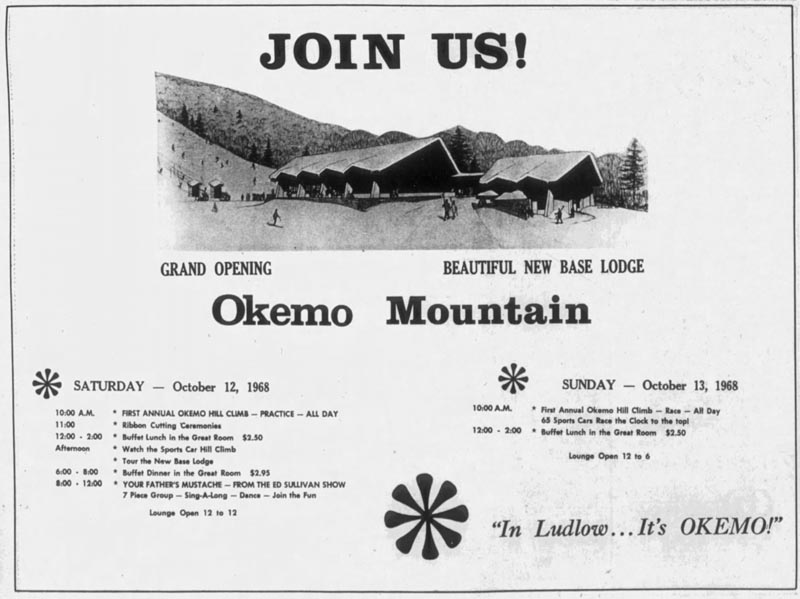
1968 base lodge dedication advertisement |
Okemo's new base lodge was dedicated on October 12, 1968 with Congressman Robert Stafford presiding, augmented by a sports car hill climb and nationally known band Your Father's Mustache performing. Designed by Wehler & Teplica of Springfield, the building included the Great Room dining area and the Sitting Bull cocktail lounge. The lower level housed offices, a larger ski shop, and a nursery. The former restaurant building was to be converted to a teenagers' club named the Mushroom Garden. The Rutland Daily Herald noted of the new building, "lights are suspended from the overhead in huge white globes resembling snowballs. The color motif is red and brown and white and black. Banks of chairs in the restaurant alternate in color from white to orange to black. An enormous hearth is the centerpiece in the lounge, with the bar in one corner and cocktail tables scattered about among cushioned red and blue chairs. Two black leather sofas before the fireplace and golden chandeliers swing above, yielding light from fixtures simulating tiny candles."
A mid-November 1968 snowstorm opened the lower mountain for skiing before Thanksgiving, hampering chairlift construction. Completion of the new lift was subsequently postponed until after the season. A large storm in mid-December validated the postponement and drew 1,200 skiers in a single day. By Christmas, Okemo was advertising base depths of one to three feet and saw business increase by 85 percent as compared to the prior year.
Circa January 1969, Okemo opened the new summit complex by providing snowcat service. By opening Mountain Road from the summit, skiers now had access to a 4.5 mile, 2,100 vertical foot run. By mid-March, Okemo was reporting base depths of nearly four to six feet and that business was 40 percent ahead of the previous winter.
In April, general manager John Anderson resigned to accept a job at Fellows Gear Shaper Company in Springfield. Former general manager Donald Cutter assumed the title of acting manager. The season likely came to a close in mid-April.
The base lodge remained in operation during the 1969 off-season, open for meals, live music (including Lee Castle with Jimmy Dorsey's band), art instruction, and culinary demonstrations as part of the "Summerscene at Okemo" program.
Significant progress was made on the new chairlift installation that summer, as a helicopter was used to pour footings and install towers. The Riblet chairlift was the first non-Poma brand installation at Okemo. In addition to the summit chairlift, improvements for the 1969-70 season included opening Mountain Road from the top, the new Rimrock trail, a new glade, and a new Mighty Mite lift. With a 2,100 foot lift-served vertical drop, Okemo would now be one of the largest ski areas in the state.
John Bassette was named general manager of Okemo in early fall 1969. A former member of the Dartmouth College ski team, Bassette had been previously employed by Pittsburgh Plate Glass Co.
The 1969-70 season likely started with "limited skiing at reduced rates" in early December before closing until the weekend before Christmas. Snow quickly accumulated, with advertised base depths approaching 5 feet by early January.
The new summit double was dedicated on February 8, with Miss Vermont Barbara Schmidt cutting the ribbon.
The Okemo Mountain Lodge (not to be confused with the base lodge) burned on the morning of Friday, March 13, 1970. Though 28 people escaped without injury, the structure, owned by Okemo Mountain Lodge Inc. and operated by Okemo Mountain Inc., was reported as a total loss.
On Easter Sunday, Okemo hosted its first annual Ralph Cup Race. Named after food services manager Ralph Hogancamp, the race was held on cafeteria trays. The season likely came to a close in mid-April.
Yet another management change took place in the summer of 1970, as David Rock was named general manager. Involved with Okemo for years, Rock had previously served as the corporate president, as well as president of the Okemo Ski Club and the Ludlow Development Corporation.
Financial Woes
The South Ridge double chairlift, Okemo's third, was installed for the 1971-72. With the new lift, Okemo now had top to bottom chairlift served skiing for the first time. Unfortunately for skiers, it would be more than a decade before the next installation, as Okemo was rolling into financial trouble. While Bromley manager Stig Albertsson attempted to purchase Okemo, he was unsuccessful.
The Muellers Take Over
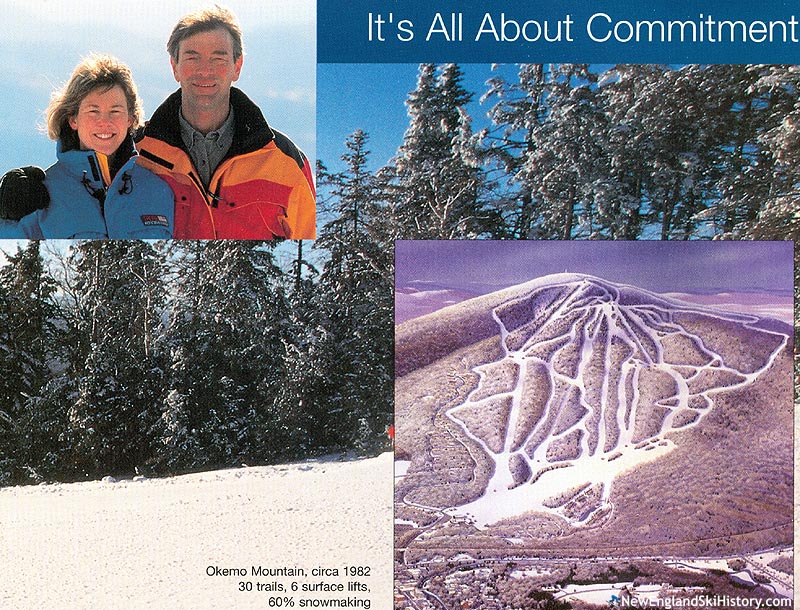
The Muellers |
By the start of the 1980s, a planned expansion was shelved while debt increased. On August 2, 1982, Tim and Diane Mueller took a principal stake in the ownership of the mountain and began a campaign of dramatic improvements.
During their first full off season, the Muellers installed the area's first triple chairlift, ushering in an era of repeated record breaking skier visit figures. Tim Mueller later told the New York Times, "Our philosophy has been to improve and maintain a first-class ski resort and ski product, and the rest will come along."
After eclipsing 300,000 skier visits, a sizable expansion took place a few years later with 1987's Solitude development.
Okemo's first detachable quad was installed for the 1992-93 season, advertised as the world's fastest high speed quad. A $1.2 million summit lodge was constructed in 1993. Around this time, the Muellers became sole owners of Okemo.
Aided by a land swap with the state, the ski area expanded again in 1994-95 with the installation of a high speed quad at Solitude, the construction of a 70 million gallon snowmaking reservoir, and the new South Face complex. Skier visits soon surpassed 500,000.
A new snowboard park was constructed in 1996, served by a T-Bar. By the end of the decade, Okemo was launching its new nordic skiing and golf facility. Meanwhile, the Muellers became operators of Mount Sunapee, NH in 1998.
Jackson Gore
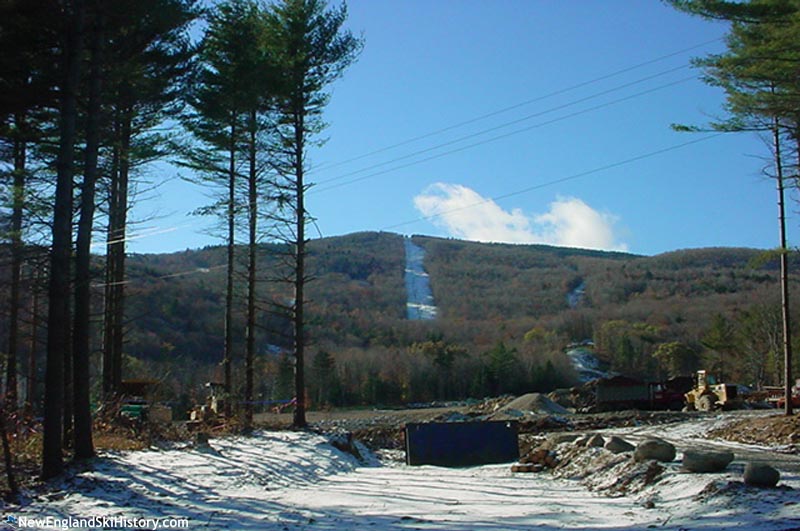
Jackson Gore, under construction in 2002 |
An ambitious project was rolled out in 2002, when a new base area and trail pod were developed on Jackson Gore. While original plans called for extensive developments such as a gondola, the implementation has been much more gradual. The main lift was installed for the 2002-03 season, whilst the base area and lower mountain lift were added for the 2003-04 season. Longtime departmental manager Bruce Schmidt was promoted to General Manager of Okemo in the summer of 2004.
On December 5, 2008, Okemo parent company Triple Peaks, LLC sold its developed ski area assets (including Okemo) to the Real Estate Investment Trust CNL Lifestyle Properties for $132 million. Triple Peaks, LLC then entered into an agreement to lease its three areas back from CNL for 40 years, therefore continuing operational control.
During the 2010 off season, the Snow Star Poma was replaced with a Magic Carpet lift, marking an end to Okemo's long Pomalift history.
More recently, Okemo has unveiled plans to develop South Face Village below South Face, providing new trails, lifts, and real estate opportunities.
Bubbles!
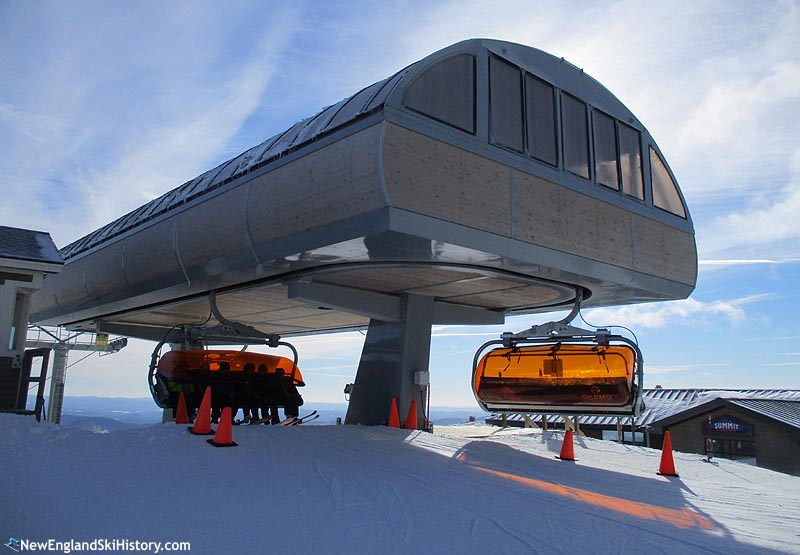
The Sun Burst Six (2016) |
During the 2014 off season, Okemo installed a new high speed six pack bubble chair, replacing the Northstar Express Quad. The following year, bubbles were installed on the Jackson Gore Express, which became known as the Quantum Four. As a result, Okemo became the only ski area in New England with two bubble chairlifts.
In June of 2018, the Muellers announced they would be selling their ski areas to Vail Resorts, ending their 36 year ownership of Okemo. In their honor, Vail Resorts renamed the Defiance trail to Muellers' Run. That fall, Bruce Schmidt was transferred to Mt. Sunapee, while Kirkwood General Manager Doug Pierini took over as Okemo General Manager, as well as COO of Vail's Northeast resorts. One year later, following the Vail acquisition of Peak Resorts, Schmidt returned as Okemo General Manager, while Pierini became COO of Vail's Eastern Region.
NewEnglandSkiConditions.com Reports
| Month |
Average Percent of Terrain Open |
| November | 13% (3 reports) |  | | December | 33% (16 reports) |  | | January | 71% (9 reports) |  | | February | 93% (5 reports) |  | | March | 92% (6 reports) |  | | April | 35% (1 report) |  |
|
| Recent Conditions Reports |
 | Dec. 29, 2024 by meirk
Wet Packed Powder, Variable Conditions |
 | Dec. 28, 2024 by meirk
Wet Packed Powder, Ice |
 | Dec. 1, 2024 by meirk
Packed Powder, Ice |
 | Apr. 14, 2024 by snowphoenix
Spring Snow, Variable Conditions |
 | Dec. 31, 2023 by meirk
Ice, Packed Powder |
|
|
| Okemo Mountain Resort on NewEnglandSkiConditions.com |
NewEnglandSkiIndustry.com News
| Recent Articles |
| Lift Construction Continues Intra-Season - Dec. 18, 2021 | | Lift Construction Continues as August Comes to a Close - Aug. 29, 2021 | | Vail Announces 2021-22 Capital Improvements - Dec. 12, 2020 | | Vail Resorts Cancels Capital Improvements, Slashes Payroll - Apr. 2, 2020 | | Vail Announces 2020-21 Capital Improvements - Dec. 9, 2019 | | Musical Chairs at Vail and Pacific Owned New England Ski Areas - Nov. 26, 2018 | | Vail Resorts Purchases Okemo and Sunapee - Jun. 4, 2018 | | Six Major Ski Areas Sold to Hedge Fund - Nov. 3, 2016 | | Vermont Re-approves Okemo South Face Village EB-5 Investment - Jul. 19, 2016 | | Vermont Halts Okemo South Face Village EB-5 Investment - Jun. 24, 2016 | | Okemo Mountain Resort NewEnglandSkiIndustry.com News Page |
Expansion History
Image Gallery
Lifts
Click on lift name for information and photos
Maps
Year by Year History
Adult Weekend Full Day Lift Ticket; Adult Full Price Unlimited Season Pass. Window price, including RFID fee and taxes when known.
| 2020s |
Ticket Price |
Season Pass Price |
Pass Payback |
Opening Day |
Closing Day |
Skier Visits |
| 2025-26 | |  | $920.00 |  | | November 22 | | |  | | | 2024-25 | $206.70 |  | $859.00 |  | 4.2 days | December 1 | April 13 | |  | | | 2023-24 | $200.34 |  | $795.00 |  | 4.0 days | November 17 | April 14 | |  | | | 2022-23 | $157.94 |  | $735.00 |  | 4.7 days | November 19 | April 16 | |  | | | 2021-22 | $142.04 |  | $619.00 |  | 4.4 days | November 26 | April 17 | |  | | | 2020-21 | $126.14 |  | $849.00 |  | 6.7 days | November 25 | April 4 | |  | | | 2019-20 | $126.14 |  | $739.00 |  | 5.9 days | November 22 | March 14 | |  | |
| 2010s |
Ticket Price |
Season Pass Price |
Pass Payback |
Opening Day |
Closing Day |
Skier Visits |
| 2018-19 | $127.20 |  | $709.00 |  | 5.6 days | November 16 | April 14 | |  | | | 2017-18 | $110.00 |  | $1375.00 |  | 12.5 days | November 11 | April 22 | |  | | | 2016-17 | $101.00 |  | $1619.00 |  | 16.0 days | November 23 | April 16 | |  | | | 2015-16 | $97.00 |  | $1599.00 |  | 16.5 days | November 24 | April 3 | |  | | | 2014-15 | $92.00 |  | $1529.00 |  | 16.6 days | November 16 | April 26 | |  | | | 2013-14 | $89.00 |  | $1499.00 |  | 16.8 days | November 13 | April 13 | |  | | | 2012-13 | $88.00 |  | |  | | November 8 | April 14 | |  | | | 2011-12 | $84.00 |  | $1419.00 |  | 16.9 days | November 24 | March 25 | |  | | | 2010-11 | $81.00 |  | $1379.00 |  | 17.0 days | November 23 | April 17 | |  | | | 2009-10 | |  | $1339.00 |  | | December 5 | April 9 | 603,000 |  | |
| 2000s |
Ticket Price |
Season Pass Price |
Pass Payback |
Opening Day |
Closing Day |
Skier Visits |
| 2008-09 | $77.00 |  | $1299.00 |  | 16.9 days | November 21 | April 12 | |  | | | 2007-08 | $74.00 |  | $1249.00 |  | 16.9 days | November 16 | April 20 | 640,000 |  | | | 2006-07 | $72.00 |  | $1229.00 |  | 17.1 days | November 23 | April 22 | |  | | | 2005-06 | $69.00 |  | $1199.00 |  | 17.4 days | November 18 | April 9 | |  | | | 2004-05 | $67.00 |  | $1325.00 |  | 19.8 days | November 12 | April 10 | |  | | | 2003-04 | $65.00 |  | $1375.00 |  | 21.2 days | November 13 | April 11 | |  | | | 2002-03 | $62.00 |  | $1240.00 |  | 20.0 days | November 2 | April 20 | 604,000 |  | | | 2001-02 | $59.00 |  | $1200.00 |  | 20.3 days | November 14 | April 14 | |  | | | 2000-01 | $56.00 |  | $1150.00 |  | 20.5 days | November 17 | April 29 | 593,000 |  | | | 1999-00 | $54.00 |  | $1150.00 |  | 21.3 days | November 11 | April 16 | |  | |
| 1990s |
Ticket Price |
Season Pass Price |
Pass Payback |
Opening Day |
Closing Day |
Skier Visits |
| 1997-98 | $50.00 |  | $1110.00 |  | 22.2 days | November 14 | | 560,000 |  | | | 1996-97 | $48.00 |  | |  | | | | 540,000 |  | | | 1995-96 | $46.00 |  | |  | | | April 21 | 508,000 |  | | | 1994-95 | $45.00 |  | |  | | | April 16 | 480,000 |  | | | 1993-94 | $43.00 |  | |  | | November 4 | | |  | | | 1992-93 | $42.00 |  | |  | | | | 465,000 |  | | | 1991-92 | $41.00 |  | |  | | November 9 | April 26 | 446,000 |  | | | 1990-91 | $39.00 |  | |  | | | | 420,000 |  | | | 1989-90 | $37.00 |  | |  | | November 5 | April 15 | 400,000 |  | |
| 1980s |
Ticket Price |
Season Pass Price |
Pass Payback |
Opening Day |
Closing Day |
Skier Visits |
| 1988-89 | $35.00 |  | |  | | November 23 | | |  | | | 1987-88 | $32.00 |  | |  | | | | 340,000 |  | | | 1986-87 | $30.00 |  | |  | | | | 320,000 |  | | | 1985-86 | |  | |  | | | | 224,000 |  | | | 1984-85 | $25.00 |  | $543.00 |  | 21.7 days | | | 165,000 |  | | | 1983-84 | $23.00 |  | $500.00 |  | 21.7 days | | | |  | | | 1982-83 | $20.00 |  | $510.00 |  | 25.5 days | | | |  | | | 1981-82 | $18.00 |  | |  | | November 25 | | 86,000 |  | | | 1980-81 | $17.00 |  | |  | | | | 95,500 |  | | | 1979-80 | $15.00 |  | |  | | | | 88,800 |  | |
| 1970s |
Ticket Price |
Season Pass Price |
Pass Payback |
Opening Day |
Closing Day |
Skier Visits |
| 1978-79 | $14.00 |  | |  | | November 23 | | |  | | | 1977-78 | $12.00 |  | |  | | December 2 | | 176,000 |  | | | 1976-77 | $12.00 |  | $300.00 |  | 25.0 days | December 3 | | |  | | | 1975-76 | $11.00 |  | |  | | December 6 | | |  | | | 1974-75 | $10.00 |  | |  | | November 28 | | |  | | | 1973-74 | $10.00 |  | |  | | | | |  | | | 1972-73 | $10.00 |  | |  | | | | |  | | | 1971-72 | $10.00 |  | $170.00 |  | 17.0 days | | | |  | | | 1970-71 | $8.50 |  | |  | | | | |  | | | 1969-70 | $8.00 |  | $125.00 |  | 15.6 days | December 6 | April 12 | 132,170 |  | |
| 1960s |
Ticket Price |
Season Pass Price |
Pass Payback |
Opening Day |
Closing Day |
Skier Visits |
| 1968-69 | $7.00 |  | $95.00 |  | 13.6 days | November 23 | April 13 | |  | | | 1967-68 | $6.00 |  | $85.00 |  | 14.2 days | December 9 | March 24 | |  | | | 1966-67 | $6.00 |  | |  | | December 22 | April 2 | |  | | | 1965-66 | |  | $75.00 |  | | December 18 | April 3 | |  | | | 1964-65 | $5.50 |  | $75.00 |  | 13.6 days | December 11 | April 11 | |  | | | 1963-64 | $5.00 |  | $65.00 |  | 13.0 days | December 20 | April 5 | |  | | | 1962-63 | $5.50 |  | $65.00 |  | 11.8 days | December 22 | | |  | | | 1961-62 | $5.00 |  | $65.00 |  | 13.0 days | December 19 | April 8 | 39,900 |  | | | 1960-61 | $5.00 |  | $65.00 |  | 13.0 days | | | |  | | | 1959-60 | $4.00 |  | $55.00 |  | 13.8 days | December 19 | | |  | |
| 1950s |
Ticket Price |
Season Pass Price |
Pass Payback |
Opening Day |
Closing Day |
Skier Visits |
| 1958-59 | |  | $55.00 |  | | November 29 | April 10 | 30,000 |  | | | 1957-58 | $4.00 |  | $55.00 |  | 13.8 days | December 7 | April 20 | 25,300 |  | | | 1956-57 | $4.00 |  | $55.00 |  | 13.8 days | December 9 | March 17 | 11,800 |  | | | 1955-56 | $5.00 |  | |  | | January 31 | April 21 | 3,000 |  | |
Visitor Memories
External Links
Okemo - official site
Ludlow Mountain - FranklinSites.com Hiking Guide
|
Last updated: October 7, 2025
|



